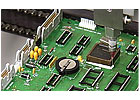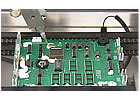
Room-temperature vulcanizing silicones (RTVs) are amazing materials. As their name implies, they cure at room temperature in hours or days, depending on the formulation. They are thermoset materials: Once cured, they can’t be transformed back to their original state regardless of what attacks them. This makes them excellent for hostile environments where other materials may degrade.
Some unique RTVs never fully cure. These are “self-healing” materials. When this type of RTV is damaged, new material under the damaged surface starts to cure. This type of material is typically used in critical military and automotive applications.
RTVs can be formulated in a wide range of consistencies, from 5,000 centipoise-the consistency of honey-to a no-slump paste that is virtually solid. Thick RTVs are thixotropic. That is, they are gel-like at rest, but fluid when agitated or pressured.
RTVs solve many challenges for assemblers of equipment destined for rugged use. They resist moisture and chemicals, and they cushion electronic assemblies, fasteners, switches and other parts against vibration and shock. These properties make RTVs an ideal choice for protecting sensors, displays and other electronics from humid or corrosive atmospheres.
Formed-in-place gaskets are another application for RTVs. Such gaskets can seal liquids inside an assembly, or keep liquids and dust out. Electrically conductive RTVs can also prevent galvanic corrosion and act as a shield against electromagnetic interference. Because they’re dispensed as a liquid, RTVs can be used to create intricate gasket paths.
Because of their thermal and chemical stability, RTVs are used in numerous applications in cars, trucks, recreational vehicles and even golf carts. They are used as gaskets for oil, coolant and air. Silicones are also used for potting and encapsulating electronic components, such as air bag sensors and wire connectors.
In the aerospace industry, RTVs seal and encapsulate critical electronics. Because of their ability to dampen vibration and endure temperature extremes, silicones are used to seal cockpit instruments, cargo doors, windows and ventilation ducts. Silicone engine gaskets and wire seals stand up to continual buffeting from turbulent air currents.
No consumer vehicle will ever see the rugged use and hostile environments that military equipment experiences, so it’s no surprise that assemblers of everything from tanks to naval cranes rely on silicones for gasketing, sealing, potting and encapsulating.
Manufacturers of heavy equipment, such as tractors, use silicones for the same reasons. Indeed, it’s not unusual for today’s tractors to be equipped with navigation systems and mini computers. RTVs keep these electronics working despite vibration, shock, heat and dust.

Dispensing RTVs
Although a wealth of RTV formulations is available, there hasn’t been a lot of options for applying them, at least until recently. Historically, RTVs were applied manually, and many assemblers continue to do this. Some have also moved to handheld semiautomatic dispensers that are aided by a pump. This is almost a requirement for dispensing extremely thick RTV formulations.While there is nothing wrong with manual dispensing, it is labor-intensive. As long as production volume warrants the investment, automated robotic dispensing systems are more cost-effective. If it can be done by an operator, a robot can do it better, faster and more precisely. However, not all automated systems are the same. A system for dispensing epoxy or solder paste may be unable to handle RTVs. Systems that can dispense thin silicones may not be well-suited for dispensing the very thick formulations used for harsh environment applications.
The PrecisionCoat automated dispensing system was designed specifically to apply RTV silicones of any viscosity. The dispense head is universal, but the needle tips vary in size depending on the type of RTV being dispensed. The dispense head can be positioned in five degrees of freedom-X, Y, Z, θQ and 0- to 60-degree tilt-so it can accomplish almost any movement that a human hand can.
Fully programmable and SMEMA-compatible, the machine can be used as a stand-alone system, or it can be integrated into an assembly line. If equipped with an optional bar code reader, the machine can scan incoming assemblies and change dispensing programs on the fly based on data from the code. Ultraviolet and thermal curing equipment can be added for RTVs that require more than just atmospheric curing.